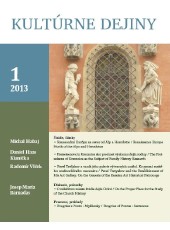Freiseisenovci z Kremnice ako predmet výskumu dejín rodiny
The Freiseisens of Kremnica as the Subject of Family History Research
Author(s): Daniel Haas KianičkaSubject(s): History
Published by: VERBUM - vydavateľstvo Katolíckej univerzity v Ružomberku
Keywords: early modern period; Hungary; Slovakia; family history research; historic demography; social history
Summary/Abstract: In the early modern period, the family constituted a fundamental social and economic unit of society. Besides family members, the household, that was understood more broadly than today, also included various servants and craftsmen. In that time marriage as the core of the family was indissoluble and bound to the property. It was the only way to get legitimate offspring, as well as the only alternative of legal sexuality. The aim of the paper was to explore the marriage age of the members of the family of Freiseisens of Kremnica, as well as the rate of entry into the second and further marriages. Another objective was to describe some of the intra-family relationships. Due to the lack of sources, it was possible to determine the age of entry into the first marriage by male members of the family in the period from the late 16th to the late 18th century only in 24 Freiseisens. The age of nine of them is approximate, while the age of the others is exact. According to calculations, the marriage age in this family was circa 26.5 years. It was a little more than the Hungarian average. The causes of this phenomenon can be found in the fact that the family came from Austria and its members sought to educationally specialize and occupationally establish themselves before marriage. And since the Freiseisens belonged to well-off families, they could afford to look for suitable economically well situated partners of an appropriate social status, and through marriage policy expand their sphere of influence. A higher age of entry into marriage had also impact on some demographic parameters. Indeed, the marriage delayed two or three years meant to conceive one or two children fewer. As for entering the second, third or fourth marriage, this phenomenon occurred in the family quite commonly. From the total of 24 family members, whose age of entry into the first marriage we sought to determine, it was directly confirmed that five members entered two marriages, one member entered three marriages and one member four marriages. This represents a nearly 30% share of two or more marriages in the lives of the family members. In that time this was considered a natural phenomenon. Men and women got married repeatedly mainly for care for their children, running their households, as well as financial security. Thanks to the family correspondence of the Freiseisens, we can also take a look at their family relationships. Particular family members manifested their mutual respect or at least tolerance. Although they were impelled to do so by social pressure, many relationships had certainly sincere character. The probe into the history of the family of Freiseisens of Kremnica showed that the existence of people in the early modern period had not been affected only by “great” events, but also, in a significant way, by their family lives. Decisions of the people had not been influenced only by social pressure, but also by their personal motives and their status in the family
Journal: Kultúrne dejiny
- Issue Year: 2013
- Issue No: 1
- Page Range: 20-34
- Page Count: 15
- Language: Slovak

